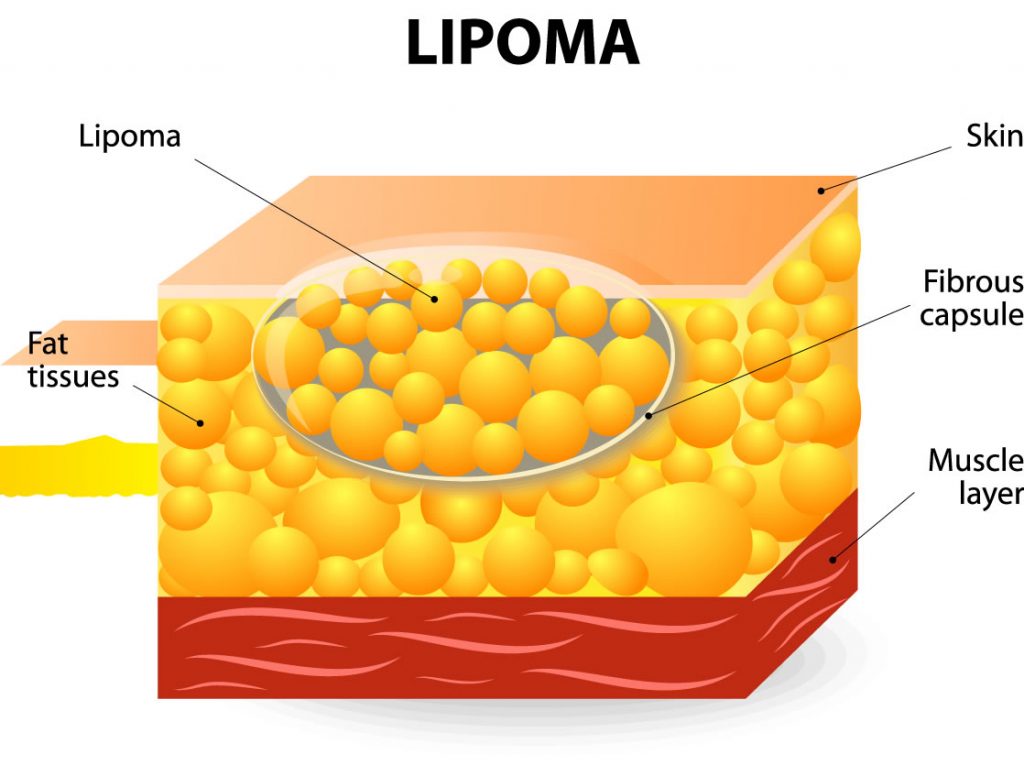Sebaceous Cyst/Lipoma Removal In Singapore
Insurance
Our surgery is on the panel of most of the major insurance companies and if you are covered by corporate insurance, you may be entitled to a cashless visit to our clinic.
Get In Touch
Table of Contents
Introduction
Lipoma and cyst removal in Singapore are a commonly performed surgery as sebaceous cysts and lipomas are common skin conditions that can affect people of all ages. While they’re typically painless, cysts can be unsightly and may cause discomfort if located on the face or neck.
Read on to find out more about these conditions, their symptoms and things you should know before considering a skin lump removal in Singapore.
What Are Lipomas?

Lipomas are soft, fatty lumps that grow under your skin. They are harmless (benign) and do not usually need any treatment. Lipomas are common and are often described as:
- Soft and squishy
- Size of a pea to a few centimetres across
- May move slightly under your skin if you press them (slip sign)
- Are not painful
- Grow slowly
What Causes Lipomas?
The exact cause of lipomas, which are benign tumours composed of fat cells, is not fully understood. However, several factors are believed to contribute to their development:
- Genetics: There appears to be a genetic predisposition to developing lipomas. They can run in families, suggesting that certain genetic factors may play a role in their formation.
- Heredity: Lipomas are more common in some families, suggesting a hereditary component. Specific genetic mutations or variations may make some individuals more prone to developing lipomas.
- Age: Lipomas are more likely to occur in adults, typically between the ages of 40 and 60, although they can develop at any age.
- Gender: There is a slightly higher prevalence of lipomas in men compared to women.
- Body Weight: While lipomas are not directly caused by obesity, there may be a correlation between being overweight or obese and an increased risk of developing lipomas.
- Trauma: In some cases, trauma or injury to an area of the body can trigger the formation of a lipoma. This is known as post-traumatic lipoma.
- Metabolic Factors: Some metabolic disorders or conditions, such as Madelung’s disease (benign symmetric lipomatosis), may be associated with an increased risk of lipoma development.
When To Seek Medical Attention?
Ironically, despite comprising benign fat cells, losing weight will not cause lipomas to shrink like normal fat cells. Lipomas are of concern if they start to grow rapidly or are painful. Rapidly enlarging lipomas may be liposarcomas which are cancerous.
You should always seek medical treatment immediately for lipoma removal in Singapore if it is causing you severe discomfort and pain.
Lipomas can also enlarge slowly till they cause discomfort due to their size. Hence sometimes surgery may be recommended. The removed lipoma is usually sent for histology to confirm its benignity. Rarely, lipomas can be painful and this is called Dercum’s disease.
How Is Lipoma Removal In Singapore Performed?
Lipoma removal is a surgical procedure performed under local anaesthesia. It involves making a small incision over the lipoma, separating it from surrounding tissues, and then closing the incision with stitches or adhesive.
Recovery is generally quick, with minimal discomfort. Pathological analysis of the removed lipoma may be conducted in some cases for diagnostic purposes. While it’s considered a low-risk procedure, potential complications and post-operative care should be discussed with a healthcare provider.
Lipoma removal are usually regarded as day surgery cases.
What Is A Sebaceous Cyst?
A sebaceous cyst is a sebum-filled lump just underneath the skin. It’s common and harmless, and may disappear without treatment. Sebaceous cysts arise from sebaceous glands (which produce sebum and keratin) in the skin. When these glands get blocked but still continue to produce sebum, a cyst wall will form under the skin.
Sebaceous cysts typically have the following appearance:
- Vary in size, ranging from small to larger growths
- Has round or oval shape
- Firm and may have some mobility under the skin
- Their colour can range from flesh-coloured to yellowish
- Red or inflamed when become infected.
- Have a small central punctum or opening on the skin’s surface, which may resemble a blackhead
- Usually painless unless they become infected or inflamed
What Causes Sebaceous Cyst To Develop?
Sebaceous cysts are typically formed due to one or more of the following factors:
- Excess Sebum Production: Sebaceous cysts often develop when the sebaceous glands produce more sebum (skin oil) than usual. This excess oil can become trapped in the gland, leading to the formation of a cyst.
- Hair Follicle Blockage: Sometimes, the opening of a hair follicle where the sebaceous gland is located can become blocked by dead skin cells, dirt, or other debris. When this occurs, sebum cannot escape, and a cyst may form.
- Inflammation or Infection: Inflammation or infection in the hair follicle or sebaceous gland can also lead to the development of a sebaceous cyst. Inflammation can cause the gland’s duct to become blocked, while infection can lead to the accumulation of pus and the formation of a cyst.
- Trauma or Injury: Physical trauma or injury to the skin can sometimes trigger the formation of a sebaceous cyst. Damage to the sebaceous gland or hair follicle can disrupt the normal flow of sebum and lead to cyst development.
- Hormonal Changes: Changes in hormonal levels, particularly an increase in androgen hormones, can influence sebum production and may contribute to the development of sebaceous cysts. This is why sebaceous cysts are more common during puberty and can also occur in conditions like polycystic ovary syndrome (PCOS).
- Genetic Factors: There may be a genetic predisposition to developing sebaceous cysts. Some individuals may have a genetic tendency to produce thicker sebum or to develop cysts more easily.

What Are The Signs Of Infection In A Sebaceous Cyst?
Signs of infection in a sebaceous cyst include
- increased pain
- tenderness
- redness
- swelling in the cyst area.
The skin may feel warm, and there may be pus or foul-smelling discharge from the cyst. Fever and systemic symptoms can also occur in severe cases.
You must avoid attempting to drain the cyst at home, as this can lead to complications.
When Should I See A Doctor About A Sebaceous Cyst?
If a sebaceous cyst is infected, starting on antibiotics and anti-inflammatory drugs may help initially, however, it does not improve over 24 to 48 hours, surgery is usually indicated. Sometimes just making a small incision to drain the pus will temporarily relieve the condition.
However, because the cyst wall is not removed, these cysts can recur and get re-infected later. The definitive treatment is to remove the entire sebaceous cyst together with the cyst wall. That is the only way to ensure that the sebaceous cyst will not recur.
How Is Sebaceous Cyst Removal In Singapore Performed?
Sebaceous cyst removal is a procedure that’s typically performed under local anaesthesia, involving a small incision to remove the whole cyst and its surrounding capsule, followed by closure with stitches.
Recovery time is quick, with proper post-operative care instructions to follow. Occasionally, cyst or content analysis may be conducted for diagnostic purposes. It’s important to discuss any potential complications and post-operative care with us, although the procedure is generally considered low-risk.
Removal of sebaceous cysts is usually done as day surgery cases.
Why You Should Go For A Lipoma & Cyst Removal Surgery In Singapore
Sebaceous cysts seldom go away on their own, and they must be surgically removed. A surgery is the most successful treatment for cysts, both medically and cosmetically. It has the lowest recurrence rate of all the procedures. Other techniques that attempt to drain or empty a sebaceous lump frequently result in remains that will ultimately build up and risk the cyst returning.
Lipomas are also similar to cysts. However, they will require no treatment unless it is causing severe discomfort or pain. Should you choose to continue, a lipoma surgery in Singapore is usually done by having an incision on the affected area to remove the lump, followed by stitches to close back the wound.
If you are unsure of your condition or wish to find out more about lipoma or cyst removal in Singapore, contact us, and we will get back to you as soon as possible.
How We Can Help Prevent Lipoma & Cyst From Recurring
Dr QM Leong is an experienced surgeon with skin surgery and its surgical procedure, who will accurately diagnose your condition for any lipoma or sebaceous cyst before determining the ideal treatment for your condition.
We are fully committed to providing a pleasant experience and treatment, so do not hesitate to call to find out about the standard procedures for skin surgery or to understand more about the process of sebaceous cyst removal in Singapore.
Frequently Asked Questions About Cyst Removal In Singapore
How Can I Tell If A Lump Is A Sebaceous Cyst Or Something Else?
To determine if a lump is a sebaceous cyst or something else, consider the location (commonly on the face, neck, scalp, or upper trunk), appearance (round or oval, flesh-coloured, yellowish, or white), mobility (usually movable under the skin), pain (typically painless unless infected), any discharge (may contain sebum), and growth rate (typically slow).
However, other skin conditions can share similar characteristics, so it’s essential to consult a healthcare provider or dermatologist for a proper evaluation and diagnosis if you have any doubts or concerns about a skin lump. They can perform an examination and recommend tests if needed to identify the lump accurately.
Can A General Practitioner Perform A Sebaceous Cyst Removal In Singapore?
Although most general practitioners in Singapore may have minor surgery, most do not perform sebaceous cyst removal in Singapore. Most of the time, you will be referred to a specialist sebaceous cyst removal clinic instead.
Is It Worth Getting A Lipoma Removal In Singapore?
Most of the time, a lipoma is not life-threatening. However, they may increase in size when there is body weight gain over time but not vice-versa.
It is also good to have a second opinion on whether you should get lipoma removal in Singapore through professional advice. Contact us today, and we will be able to help you understand your condition better.
How Much Does A Lipoma Removal Cost In Singapore?
Generally, the price of lipoma removal in Singapore may range from a few hundred to several thousand Singapore dollars. The actual cost will depend on several factors, including the size and location of the lipoma, the method of removal chosen, the healthcare facility or clinic where the procedure is performed, and the surgeon’s fees.
How Much Does An Epidermal Or Sebaceous Cyst Removal Cost In Singapore?
Can I Remove My Lipoma Myself?
Many do-it-yourself (DIY) removal videos show how home remedies can work without proper anaesthesia or adequately sanitised equipment.
However, it is WHAT YOU SHOULD NOT DO. There are many risks involve when it comes to at-home surgery, you may even risk getting an open wound infection or permanent scarring. Even though lipomas might not be hazardous to your health, most people will opt to have them removed professionally through surgical excision.
To find out more about your condition, do contact us through WhatsApp. We will get back to you as soon as possible.
About Dr QM Leong
Colorectal & Hernia Surgeon in Singapore
Dr Leong is a general and colorectal surgeon in Singapore who graduated from the University of London in 2000. He obtained his membership to the Royal College of Surgeons of Edinburgh in 2003 and started working in Tan Tock Seng Hospital in 2003. He started his Advanced Specialist Training in 2005 and passed his fellowship exams in 2008. Dr Leong was awarded the prestigious MOH HMDP scholarship to train under Prof Kim Seon Hahn in Korea University for Laparoscopic and Robotic colorectal surgery in 2010.
Dr Leong is amongst a handful of hernia and colorectal surgeons in Singapore who practice Single Incision Laparoscopic surgery. This is a technical and complex procedure that is minimally invasive, speeds up recovery, and confers excellent cosmetic results. Dr Leong also routinely trains basic and advanced specialist trainees in laparoscopic surgery, and regularly proctors consultant surgeons in complex colorectal cases.
Beyond laparoscopic surgery, Dr Leong also performs a repertoire of minimally invasive General Surgery procedures. He is also an experienced endoscopist with more than 10000 procedures, performing diagnostic and therapeutic scopes for elective and emergency surgical conditions. He performs direct access colonoscopies and oesophago-gastro-duodenoscopy for patients and will strive to perform the procedures on the same day if possible for patients’ convenience.

Insurance
Our surgery is on the panel of most of the major insurance companies and if you are covered by corporate insurance, you may be entitled to a cashless visit to our clinic.
Get In Touch
Corporate Insurance Partners











Personal Insurance Partners







